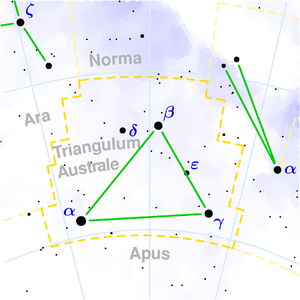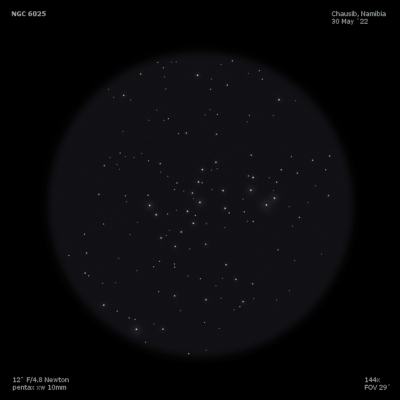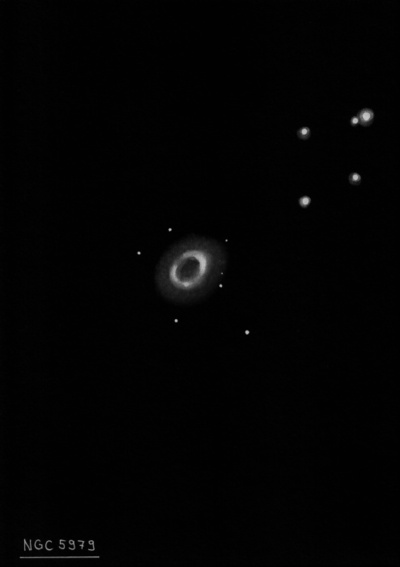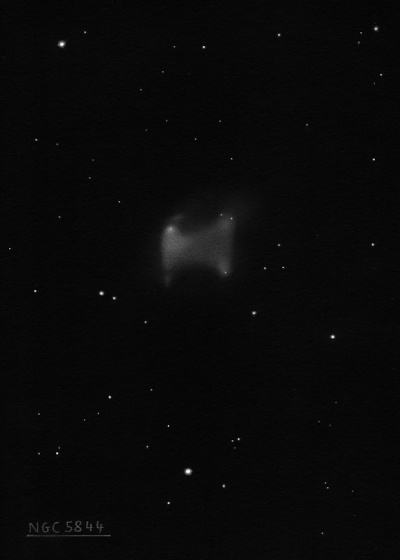A small but prominent constellation in the southern sky, not visible in our latitudes. It is located in the Milky Way, surrounded by the Norma, the Circinus, the Octant and the Telescope, so this part of the sky can be considered part of the equipment of the navigators of old. The three bright stars of the constellation shine at the vertices of an isosceles triangle, which is easy to find in the sky because of its regular shape and its proximity to Toliman and Hadar of Centaur. At its northern edge, the diffuse open cluster NGC 6025 can be seen with the naked eye on a good night.

Atria (α TrA) - The brightest star of the constellation is a 2nd magnitude star. The orange color of this star is noticeable even with the naked eye. It is located at a distance of 80 light years. Its name Atria is an abbreviation of the words alpha Triangulum Australis, which were introduced by air navigators during World War II.
β TrA - The main component has a brightness of 2.9 mag and is separated by 155 "from a "faint companion of 14 mag, which is not physically related to it. The brighter component has a white hue and is located 40 light-years away.
S TrA - Another bright Cepheid. This time with a period of 6.323 days and a magnitude range from 6.1 to 6.7.
R TrA - Cepheid variable changing its brightness by almost one magnitude: 6-6.8 mag with a period of 3.389 days. For cepheids that change their brightness so rapidly, determining their brightness once per night is insufficient.
NGC 6025

The cluster straddles TrA and Norma and was just visible naked-eye. Abell 3627 (the core of the "Great Attractor"!) lies 1.5 degrees southeast and deep images show a number of very faint galaxies within and around the borders of the cluster that are probably outlying members.
Nicolas-Louis de Lacaille discovered NGC 6025 = Lac III 10 = D 304 = h1941 in 1751-1752 using a 1/2" telescope at 8x during his expedition to the Cape of Good Hope. With this small telescope he noted "three faint stars in line in nebulosity." Dunlop observed the cluster 5 times with his 9-inch reflector from Parramatta and recorded "(Lambda Circini) Lacaille describes this as three small stars in a line with nebula. No particular nebula exists in this place. A group of about twenty stars of mixt magnitudes, forming an irregular figure, about 5' or 6' long, answer to the place of the Lambda. This is in the milky way; and there is no nebula in the group of stars except what is common in the neighbourhood."
John Herschel lists 4 observations in the Cape Catalogue: on his first sweep (22 Apr 1835) he logged "VII.; loose; scattered; brilliant; stars large; much more than fills field; 46 stars counted above 12th mag; chief star 7th mag taken." On a second sweep as ""Chief star 7th mag of a large, oblong, bright scattered cluster, stars 7..10th mag."
400/500mm - 18" (7/7/02 - Magellan Observatory, Australia): at 76x using a 27mm Panoptic, this cluster was a very pretty sight. It appeared loose but bright and large, ~13' diameter, with 50-60 stars resolved. A couple of dozen stars are mag 11.5 or brighter and seem to form a continuous loop or exaggerated "S" shape with no central concentration! At 128x, ~80 stars were visible but the cluster was really too large for a good view at this power. Two brighter mag 7 and 8 stars are at the SE end (HD 143448, the northern one, is the brightest in the cluster and a Be type) with mag 8.5 and 9 stars near the NW edge.
Notes by Steve Gottlieb
NGC 5979

John Herschel discovered NGC 5979 = h3610 on 24 Apr 1835 and recorded "planetary nebula. Not B; pF; S; R; with something like a protuberance, which may arise from an accidental star, on or close to the edge. Not quite sharp; a little furred; light not quite uniform; an odd sort of mottling like a resolvable light; taken at first for a vF double star out of focus; 12" diameter; but seen with 240; 320 is too high a power for it. See figure 7, plate VI." On 16 Jun 1835, he recorded "planetary; transit just missed; R; 5" diam; about equal in light to a * 9m; of a feeble intensity of light; nearly equable; under 320 it is not nebulous; but indistinct at the edges; a very singular kind of appearance - not "mottled", not "curdled", but yet not planetary. In a field with about 100 or 150 stars. His position is accurate, but due to a reduction error the NGC position is 1.0 minute too far west (corrected in the IC 2 Notes section).
Joseph Turner sketched the planetary as annular and brighter or a thicker rim on the north side using the Great Melbourne Telescope (unpublished plate VII, figure 72).
400/500mm - 18" (7/7/02 - Magellan Observatory, Australia): at 171x and UHC filter, NGC 5979 appeared moderately bright, small, round. The disc was ~15" diameter and fairly evenly lit. It appeared larger than the catalogued size of 8". At 228x (unfiltered), the surface brightness was slightly irregular with possibly a very faint halo or the halo dims at the periphery. Set in a rich star field with a mag 10 star 2.7' S. A distinctive trail of mag 12-13 stars meanders off to the east. Located in the northwest corner of Triangulum Australe, about a degree from the Norma border.
Notes by Steve Gottlieb
NGC 5844

This object is listed in the PK and ESO-Strausberg catalogues as He 2-119 instead of NGC 5844 although John Herschel's position (from two observations) matches this planetary. Also, it was listed as an unverified southern object in the RNGC and probably because of this error was not included in Sky Atlas 2000.0, Sky Catalogue 2000.0 or the first edition of the Uranometria 2000!
John Herschel discovered NGC 5844 = h3591 on 2 May 1835 and recorded "pB; R; vgvlbM; 60"." His position on two sweeps is accurate. DeLisle Stewart called it "Three very faint nebulae only" (repeated in the IC2 Notes section).
This PN is listed in the PK and ESO-Strausberg catalogues as He 2-119 but the identification with NGC 5844 was only made recently! RNGC classifies it an unverified southern object and it is not included in Sky Atlas 2000.0, Sky Catalogue 2000.0 and first edition of the Uranometria 2000.0!
400/500mm - 18" (7/10/05 - Magellan Observatory, Australia): excellent view of this interesting object at 128x with a UHC filter. Using this combination, the planetary appeared moderately bright and large with an irregular shape and surface brightness, but elongated ~0.9'x0.7' WSW-ENE, . At 228x, the northeast end is brighter and larger and the center seems pinched in, particularly on the north side with a small, faint extension or knot on the southwest end. Unfiltered at 228x, a fairly close double (B 832 = 9/10.5 at 5") lies 3' NE and a very close, faint double lies 1.3' SE of center. Located 3° ENE of mag 3.2 Alpha Circini.
18" (7/8/02 - Magellan Observatory, Australia): this fairly bright, moderately large planetary was quite interesting at 171x and a UHC filter. It was elongated 3:2 E-W, ~55"x40". It appeared brighter on the following end with an indentation or notch on the north side giving the impression of a bipolar structure. Set in a rich Triangulum Australe star field 3' SW of a mag 9 double star (9/10.5 at 6"). Also a mag 10.5 star lies 2.5' E.
Notes by Steve Gottlieb